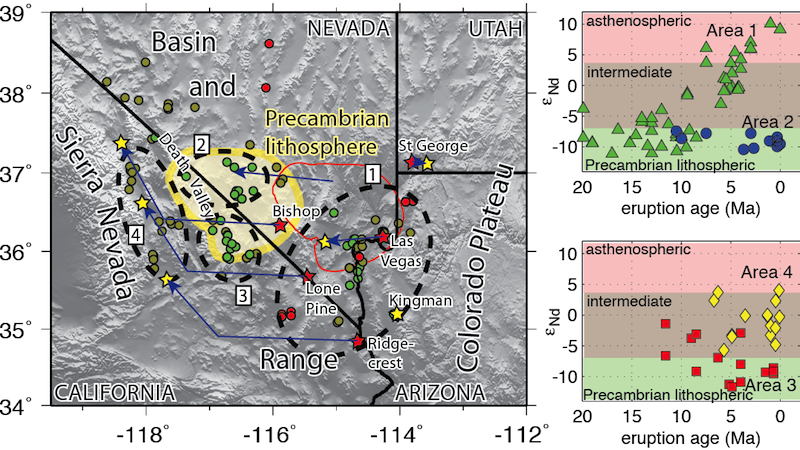2012 IRIS Workshop
Differential Motion Between Upper Crust and Lithospheric Mantle in the Central Basin and Range
Vera Schulte-Pelkum: U Colorado Boulder, Glenn Biasi: U Nevada Reno, Anne Sheehan: U Colorado Boulder, Craig Jones: U Colorado Boulder
Map on left shows relative city locations pre- (red stars) and post-(yellow stars) Cenozoic extension (blue arrows, Snow & Wernicke, 2000), antibuoyant lithospheric keel in yellow with outline -1 km mantle contribution to surface elevation (pre-extension inferred position in red), basalt sample locations (circles). Right, time progression of basalt eNd ratios in areas 1-4 on map. The Precambrian mantle keel detached from the Colorado Plateau and was stranded when extension jumped to Death Valley.

Full-resolution graphics file in original format: 0068.png
Cenozoic crustal extension has more than doubled the surface area of the Central Basin and Range (extending roughly from the Garlock Fault north to 37N, between the Colorado Plateau and Sierra Nevada in the western U.S.), but it is unknown whether the lithosphere thins coherently with the upper crust (pure shear), if deep extension is laterally offset (simple shear), or if the deeper lithosphere is entirely decoupled from surface extension. The Central Basin and Range province is unusual, compared with its northern and southern counterparts: extension began much later; encroaching large-volume ignimbrite volcanism stopped at the northern and southern boundaries; and unusual basalt isotope ratios suggest a Precambrian mantle source. We use receiver function crustal thicknesses and isostatic calculations to map lithospheric thickness in the area. We identify an isolated root of ancient mantle lithosphere that is ≥125 km thick, providing geophysical conĀrmation of a strong, cold mantle previously inferred from basalt geochemistry. We suggest that the root caused the later onset of extension and prevented the eruption of voluminous volcanism at the surface. We infer that the root initially pulled away from the Colorado Plateau along with the crust, but then was left behind intact during extension across Death Valley to the Sierra Nevada. Recent southward motion of enriched basalts suggests that the upper crust is now decoupled from and moving relative to the mantle root.
Acknoweldgements: This study was funded by NSF award EAR-0838509.
For further reading: V. Schulte-Pelkum, G. Biasi, A. F. Sheehan, and C. H. Jones (2011), Differential motion between upper crust and lithospheric mantle in the Central Basin and Range, Nature Geoscience 4(9), 619-623. doi: 10.1038/ngeo1229
Keywords: lithosphere-asthenosphere_boundary, receiver_functions, isostatic_compensation, mantle_density, basalt_geochemistry
